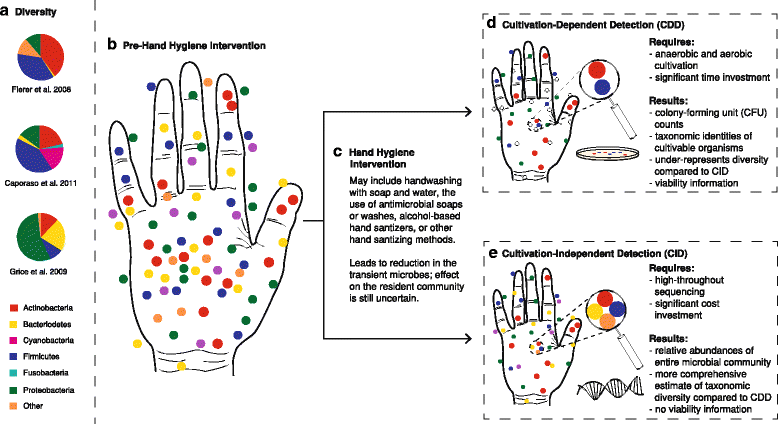Cleanliness in context: reconciling hygiene with a modern microbial perspective
- PMID: 28705228
- PMCID: PMC5513348
- DOI: 10.1186/s40168-017-0294-2
Cleanliness in context: reconciling hygiene with a modern microbial perspective
Abstract
The concept of hygiene is rooted in the relationship between cleanliness and the maintenance of good health. Since the widespread acceptance of the germ theory of disease, hygiene has become increasingly conflated with sterilization. In reviewing studies across the hygiene literature (most often hand hygiene), we found that nearly all studies of hand hygiene utilize bulk reduction in bacterial load as a proxy for reduced transmission of pathogenic organisms. This treatment of hygiene may be insufficient in light of recent microbial ecology research, which has demonstrated that humans have intimate and evolutionarily significant relationships with a diverse assemblage of microorganisms (our microbiota). The human skin is home to a diverse and specific community of microorganisms, which include members that exist across the ecological spectrum from pathogen through commensal to mutualist. Most evidence suggests that the skin microbiota is likely of direct benefit to the host and only rarely exhibits pathogenicity. This complex ecological context suggests that the conception of hygiene as a unilateral reduction or removal of microbes has outlived its usefulness. As such, we suggest the explicit definition of hygiene as "those actions and practices that reduce the spread or transmission of pathogenic microorganisms, and thus reduce the incidence of disease."
Keywords: Hand hygiene; Hygiene; Microbial ecology; Microbiome; Microbiota; Skin.
Conflict of interest statement
Ethics approval and consent to participate
Not applicable.
Consent for publication
Not applicable.
Competing interests
The authors declare that they have no competing interests.
Publisher’s Note
Springer Nature remains neutral with regard to jurisdictional claims in published maps and institutional affiliations.
Figures


Similar articles
-
A 21st century view of infection control in everyday settings: Moving from the Germ Theory of Disease to the Microbial Theory of Health.Am J Infect Control. 2020 Nov;48(11):1387-1392. doi: 10.1016/j.ajic.2020.05.012. Epub 2020 May 19. Am J Infect Control. 2020. PMID: 32442651 Free PMC article. Review.
-
Reconciling Hygiene and Cleanliness: A New Perspective from Human Microbiome.Indian J Microbiol. 2020 Mar;60(1):37-44. doi: 10.1007/s12088-019-00839-5. Epub 2019 Nov 12. Indian J Microbiol. 2020. PMID: 32089572 Free PMC article. Review.
-
Microbial (co)infections: Powerful immune influencers.PLoS Pathog. 2022 Feb 3;18(2):e1010212. doi: 10.1371/journal.ppat.1010212. eCollection 2022 Feb. PLoS Pathog. 2022. PMID: 35113966 Free PMC article. Review.
-
Comparison of Standard Culture-Based Method to Culture-Independent Method for Evaluation of Hygiene Effects on the Hand Microbiome.mBio. 2017 Mar 28;8(2):e00093-17. doi: 10.1128/mBio.00093-17. mBio. 2017. PMID: 28351915 Free PMC article.
-
Smartphones as an Ecological Niche of Microorganisms: Microbial Activities, Assembly, and Opportunistic Pathogens.Microbiol Spectr. 2022 Oct 26;10(5):e0150822. doi: 10.1128/spectrum.01508-22. Epub 2022 Aug 30. Microbiol Spectr. 2022. PMID: 36040152 Free PMC article.
Cited by
-
2019 Novel Coronavirus (COVID-19) Pandemic: Built Environment Considerations To Reduce Transmission.mSystems. 2020 Apr 7;5(2):e00245-20. doi: 10.1128/mSystems.00245-20. mSystems. 2020. PMID: 32265315 Free PMC article. Review.
-
The Future of Functional Clothing for an Improved Skin and Textile Microbiome Relationship.Microorganisms. 2021 May 31;9(6):1192. doi: 10.3390/microorganisms9061192. Microorganisms. 2021. PMID: 34073029 Free PMC article. Review.
-
A 21st century view of infection control in everyday settings: Moving from the Germ Theory of Disease to the Microbial Theory of Health.Am J Infect Control. 2020 Nov;48(11):1387-1392. doi: 10.1016/j.ajic.2020.05.012. Epub 2020 May 19. Am J Infect Control. 2020. PMID: 32442651 Free PMC article. Review.
-
Hand Hygiene Habits of Ghanaian Youths in Accra.Int J Environ Res Public Health. 2019 Jun 3;16(11):1964. doi: 10.3390/ijerph16111964. Int J Environ Res Public Health. 2019. PMID: 31163599 Free PMC article.
-
Human Skin Microbiome: Impact of Intrinsic and Extrinsic Factors on Skin Microbiota.Microorganisms. 2021 Mar 5;9(3):543. doi: 10.3390/microorganisms9030543. Microorganisms. 2021. PMID: 33808031 Free PMC article. Review.
References
-
- hygiene, n [Internet]. OED Online. Oxford, UK: Oxford University Press; [cited 2016 Sep 19]. Available from: http://www.oed.com/view/Entry/90139
-
- World Health Organization . WHO guidelines on hand hygiene in health care: first global patient safety challenge. Geneva: World Health Organization; 2009. - PubMed
-
- World Health Organization . The global water supply and sanitation assessment. Geneva: World Health Organisation; 2000.
Publication types
MeSH terms
LinkOut - more resources
Full Text Sources
Other Literature Sources
Research Materials

